Welcome! AsianBondsOnline is a one-stop source of information on bond markets in emerging East Asia.
Publications
Sustainable Bond Related Publications (ADB and ADBI)
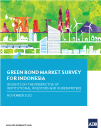
Green Bond Market Survey for Indonesia: Insights on the Perspectives of Institutional Investors and Underwriters
December 2022
This publication provides an overview of institutional investors’ interest in green bonds issued in Indonesia, along with an assessment of the perspectives of local arrangers and underwriters on their clients’ interest in green bond issuances. It presents the results of a survey to help identify drivers, impediments, and development priorities for Indonesia’s sustainable finance market.
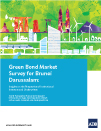
Green Bond Market Survey for Brunei Darussalam: Insights on the Perspectives of Institutional Investors and Underwriters
December 2022
This publication provides an overview of institutional investors’ interest in green bonds issued in Brunei Darussalam, along with an assessment of the perspectives of local arrangers and underwriters on their clients’ interest in green bond issuances. It presents the results of a survey to help identify drivers, impediments, and development priorities for Brunei Darussalam’s sustainable finance market.

Green Bond Market Survey for Singapore: Insights on the Perspectives of Institutional Investors and Underwriters
November 2022
This publication provides an overview of institutional investors' interest in green bonds issued in Singapore, along with an assessment of the perspectives of local arrangers and underwriters on their clients' interest in green bond issuances. It presents the results of a survey to help identify drivers, impediments, and development priorities for Singapore's sustainable finance market. The findings and insights presented in this publication are intended to inform how the Asian Development Bank and other partners could further support the market's development.
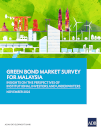
Green Bond Market Survey for Malaysia: Insights on the Perspectives of Institutional Investors and Underwriters
November 2022
This publication provides an overview of institutional investors' interest in green bonds issued in Malaysia, along with an assessment of the perspectives of local arrangers and underwriters on their clients' interest in green bond issuances. It presents the results of a survey to help identify drivers, impediments, and development priorities for Malaysia's sustainable finance market. The findings and insights presented in this publication are intended to inform how the Asian Development Bank and other partners could further support the market's development.
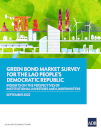
Green Bond Market Survey for the Lao People's Democratic Republic: Insights on the Perspectives of Institutional Investors and Underwriters
September 2022
This publication provides an overview of institutional investors' interest in green bonds issued in Lao People's Democratic Republic, along with an assessment of the perspectives of local arrangers and underwriters on their clients' interest in green bond issuances. It presents the results of a survey to help identify drivers, impediments, and development priorities for Lao People's Democratic Republic's sustainable finance market. The findings and insights presented in this publication are intended to inform how the Asian Development Bank and other partners could further support the market's development.
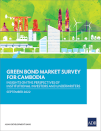
Green Bond Market Survey for Cambodia: Insights on the Perspectives of Institutional Investors and Underwriters
September 2022
This publication provides an overview of institutional investors' interest in green bonds issued in Cambodia, along with an assessment of the perspectives of local arrangers and underwriters on their clients' interest in green bond issuances. It presents the results of a survey to help identify drivers, impediments, and development priorities for Cambodia's sustainable finance market. The findings and insights presented in this publication are intended to inform how the Asian Development Bank and other partners could further support the market's development.
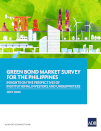
Green Bond Market Survey for the Philippines: Insights on the Perspectives of Institutional Investors and Underwriters
July 2022
This publication provides an overview of institutional investors' interest in green bonds in the Philippines and the perspectives of local arrangers and underwriters on their clients' interest in green bond issuance.

Detailed Guidance for Issuing Green Bonds (Cambodian version)
July 2022
This publication provides guidance for bond issuers in Cambodia and their advisors on the process and key considerations for a successful green bond issuance.
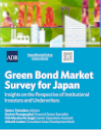
Green Bond Market Survey for Japan: Insights on the Perspectives of Institutional Investors and Underwriters
July 2022
This publication provides an overview of institutional investors' interest in green bonds in Japan and the perspectives of local arrangers and underwriters on their clients' interest in green bond issuance.
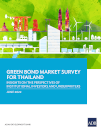
Green Bond Market Survey for Thailand: Insights on the Perspectives of Institutional Investors and Underwriters
June 2022
This publication provides an overview of institutional investors' interest in green bonds in Thailand and the perspectives of local arrangers and underwriters on their clients' interest in green bond issuance.
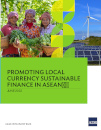
Promoting Local Currency Sustainable Finance in ASEAN+3
June 2022
This report provides an update on the local currency sustainable bond markets in the Association of Southeast Asian Nations and the People's Republic of China, Japan, and the Republic of Korea (ASEAN+3). Historically, green bonds have dominated the sustainable debt market in ASEAN+3, but the coronavirus disease (COVID-19) pandemic has spawned the next generation of social- and sustainability-labeled instruments to fund a broader range of environmental and social benefits. This report provides a comprehensive summary of regional developments, identifies existing obstacles and challenges, highlights green investment opportunities in key sectors, and offers practical recommendations to further develop sustainable local currency bond markets in ASEAN+3.
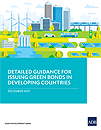
Detailed Guidance for Issuing Green Bonds
December 2021
Demand for green bonds and other sustainable finance products is increasing rapidly, and issuers are seeing an opportunity to be part of the green bond market. This publication covers all the steps required to follow best practices in labeling bonds as green. It includes examples, links to further details, and key resources for green bond issuers and their deal teams.
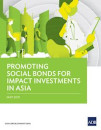
Promoting Social Bonds for Impact Investments in Asia
May 2021
The social bond market has grown rapidly amid the coronavirus disease (COVID-19) pandemic. This report explores ways of maximizing the impact of social bonds for sustainable development and of supporting a well-functioning social bond market. It analyzes the impact areas that social bonds have addressed to date and introduces the impact measurement techniques that are in use and under development. It notes the need for common standards of information disclosure and impact measurement.

Green, Sustainability and Social Bonds for COVID-19 Recovery: A Thematic Bonds Primer by the ACGF
February 2021
The ASEAN Catalytic Green Finance Facility (ACGF) has published a primer outlining thematic bonds which will be critical to help finance COVID-19 recovery programs and projects, while addressing specific SDG targets including on climate change, environmental sustainability, sustainable infrastructure, and social protection.

Primer on Social Bonds and Recent Developments in Asia
February 2021
This publication explains how social bond market development in Asia can support an inclusive and sustainable recovery from the coronavirus disease (COVID-19).

ASEAN Catalytic Green Finance Facility 2019–2020: Accelerating Green Finance in Southeast Asia
January 2021
This document presents progress made and early achievements as of December 2020 from the pilot phase of the ASEAN Catalytic Green Finance Facility (ACGF) (2019-2021).

Green Infrastructure Investment Opportunities: Philippines 2020 Report
November 2020
This report explores green bonds and other finance instruments for climate-resilient infrastructure and investment opportunities that can support the Philippines in achieving a low carbon economy.

Green Finance Strategies for Post-COVID-19 Economic Recovery in Southeast Asia: Greening Recoveries for Planet and People
October 2020
This publication examines innovative finance mechanisms for government recovery strategies that can incentivize green infrastructure investment in developing Asia and support the fight against the coronavirus disease (COVID-19) pandemic.

ADB Green Bonds Newsletter and Impact Report 2020
July 2020
This issue covers sustainable development challenges in Asia and the Pacific, ADB's strategies for addressing these challenges, the bank's recent green bond issuances, and projects eligible for green bond financing.

Green, Social, and Sustainability Bonds for Asia and the Pacific
July 2020
This publication highlights how green bonds can help fund projects supporting climate change mitigation, adaptation, and resilience. It also features milestones achieved and successful projects implemented in Asia and the Pacific.

ASEAN Catalytic Green Finance Facility
January 2020
The ASEAN Catalytic Green Finance Facility (ACGF) is an innovative financing facility designed to scale up green infrastructure projects in Southeast Asia.

Green Bonds for Financing Renewable Energy and Energy Efficiency in Southeast Asia: A Review of Policies
January 2020
Mobilizing private finance for renewable energy and energy efficiency is critical for the Association of Southeast Asian Nations (ASEAN) not only for the reduction of global temperature rise, but also for meeting fast-growing energy demand. Two-thirds of green bonds issued in ASEAN countries were used to finance renewable energy and energy efficiency projects.

ASEAN Infrastructure Fund: Financing Infrastructure for Growth and Development
September 2019
The ASEAN Infrastructure Fund (AIF) promotes regional infrastructure financing to support the long-term development of countries in Southeast Asia.
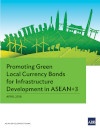
Promoting Green Local Currency Bonds for Infrastructure Development in ASEAN+3
April 2018
The Asian Development Bank and the Association of Southeast Asian Nations and the People's Republic of China, Japan, and the Republic of Korea (ASEAN+3) are looking to explore options to promote green local currency-denominated bonds to meet the region's infrastructure development needs. Green bonds—supported within the ASEAN+3 framework—would help meet the long-term financing of the region especially in its transition to a low-carbon region. This publication highlights an assessment study of green bond markets in ASEAN+3, identifies the barriers to green bond market development, and proposes recommendations to scale up green bond markets for infrastructure development in ASEAN+3.

Catalyzing Green Finance: A Concept for Leveraging Blended Finance for Green Development
August 2017
This publication describes an innovative financing solution for enhancing both financially bankable as well as environmentally sustainable infrastructure projects.
Sustainable Bond Related Publications (External)
ASEAN Capital Markets Forum (ACMF)

Roadmap for ASEAN Sustainable Capital Markets
October 2020
ACMF has developed the Roadmap for ASEAN Sustainable Capital Markets (Roadmap) comprising actionable recommendations to provide strategic direction and guide ACMF and its members in developing action plans and initiatives across the region, building on its recent efforts in the sustainability sphere.

ASEAN Sustainability Bond Standards
October 2018
The ASEAN Sustainability Bond Standards (ASEAN SUS) intend to provide guidance on the issuance of ASEAN Sustainability Bonds. ASEAN Sustainability Bonds are bonds where the proceeds will be exclusively applied to finance or re-finance a combination of both Green and Social Projects that respectively offer environmental and social benefits.

ASEAN Social Bond Standards
October 2018
The ASEAN Social Bond Standards (ASEAN SBS) was developed to complement the ASEAN Green Bond Standards that were first introduced in November 2017. The ASEAN SBS intend to enhance transparency, consistency and uniformity of ASEAN Social Bonds which will also contribute to the development of a new asset class, reduce due diligence cost and help investors to make informed investment decisions.

ASEAN Green Bond Standards
Revised: October 2018
The ASEAN Green Bonds Standards is an initiative that facilitates ASEAN capital markets in tapping green finance to support sustainable regional growth and meet investor interest for green investments and is part of the ACMF's broader efforts in developing green finance for the region.
International Capital Market Association (ICMA)

The Social Bond Principles (SBP) 2021
June 2021
Social bonds are use of proceeds bonds that raise funds for new and existing projects with positive social outcomes. The Social Bond Principles (SBP) seek to support issuers in financing socially sound and sustainable projects that achieve greater social benefits. SBP-aligned issuance should provide transparent social credentials alongside an investment opportunity. SBP-aligned issuance should provide transparent social credentials alongside an investment opportunity. By recommending that issuers report on the use of Social Bond proceeds, the SBP promote a step change in transparency that facilitates the tracking of funds to social projects, while simultaneously aiming to improve insight into their estimated impact.

The Green Bond Principles (GBP) 2021
June 2021
Green bonds enable capital-raising and investment for new and existing projects with environmental benefits. The Green Bond Principles (GBP) seek to support issuers in financing environmentally sound and sustainable projects that foster a net-zero emissions economy and protect the environment. GBP-aligned issuance should provide transparent green credentials alongside an investment opportunity. By recommending that issuers report on the use of Green Bond proceeds, the GBP promote a step change in transparency that facilitates the tracking of funds to environmental projects, while simultaneously aiming to improve insight into their estimated impact.

Pre-issuance Checklist for Social Bonds/Social Bond Programmes
June 2021
This document aims to give guidance on the steps for establishing a Social Bond Framework as recommended by the 2021 edition of the Social Bond Principles (SBP)1.

Guidelines for Green, Social, Sustainability and Sustainability-Linked Bonds' Impact Reporting Databasesz
June 2021
In conjunction with the rapidly expanding market for green, social, sustainability and sustainability-linked bonds, recent years have seen the emergence of digital platforms aimed at collecting and presenting data related to these instruments, particularly data related to the environmental and/or social Impacts arising from the sustainable investments underpinning by such bonds.

The GBP Impact Reporting Working Group – Suggested Impact Reporting Metrics for Circular Economy and/or Eco-Efficient Projects
June 2021
This document provides core quantitative indicators for eco-efficient and circular economy projects as well as reference reporting templates that issuers can adapt to their own circumstances. These templates make reference to the most commonly used indicators, however, the working group acknowledges that other indicators might be relevant as well, particularly since the development of indicators for circular economy is an on-going task at international level.

Green Project Mapping
June 2021
This document aims to provide a broad frame of reference by which issuers, investors, underwriters and other bond market participants can relate and evaluate the benefits and contribution of the GBP's Green Project categories to its own stated five environmental objectives (i.e. Climate Change Mitigation, Climate Change Adaptation, Natural Resource Conservation, Biodiversity Conservation, and Pollution Prevention and Control). It also provides a basis for comparison to other green taxonomies and classification systems currently used in the market.

Guidance Handbook
June 2021
This edition of the Guidance Handbook, reflects the publication of the newly established SLBP and the Climate Transition Finance Handbook, as well as updated versions of the GBP, SBP, and SBG, published in 2021.

Sustainability-Linked Bond Principles
June 2020
Sustainability-Linked Bond Principles provide guidelines that recommend structuring features, disclosure and reporting. They are intended for use by market participants and are designed to drive the provision of information needed to increase capital allocation to such financial products. The SLBP are applicable to all types of issuers and any type of financial capital market instruments.
SLB-WGKPIs-080621 (pdf)
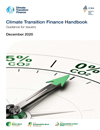
Climate Transition Finance Handbook
December 2020
The Climate Transition Finance Handbook acts as additional guidance for issuers seeking to utilise green bonds, sustainability bonds or sustainability-linked bonds towards the achievement of their climate transition strategy. When raising funds for climate transition-related purposes, issuers are encouraged to reference the recommendations outlined in the Climate Transition Finance Handbook in their reporting. For related questions, click here. See also the related news.

Social Bond Principles
June 2020
The Social Bond Principles (SBP) updated as of June 2020 promote integrity in the Social Bond market through guidelines that recommend transparency, disclosure and reporting.

Sustainability Bond Guidelines
June 2018
The Sustainability Bond Guidelines as of June 2018 have been published to confirm the relevance of the Principles in this context and facilitate the application of their guidance on transparency and disclosure to the Sustainability Bond market.

Sustainability-Linked Bond Principles
June 2020
Sustainability-Linked Bond Principles provide guidelines that recommend structuring features, disclosure and reporting. They are intended for use by market participants and are designed to drive the provision of information needed to increase capital allocation to such financial products. The SLBP are applicable to all types of issuers and any type of financial capital market instruments.

Guidelines for Green, Social and Sustainability Bonds External Reviews
June 2020
These Guidelines for External Reviewers provide voluntary guidance relating to professional and ethical standards for external reviewers, as well as to the organisation, content and disclosure for their reports.

Green and Social Bonds: A High-Level Mapping to the Sustainable Development Goals
June 2020
This High-Level Mapping to the Sustainable Development Goals aims to provide a broad frame of reference by which issuers, investors and bond market participants can evaluate the financing objectives of a given Green, Social or Sustainability Bond Programme against the Sustainable Development Goals (SDGs).

Handbook - Harmonize Framework for Impact Reporting
April 2020
The Handbook – Harmonized Framework, first published in June 2019, and updated in April 2020, merges the “Proposal for a harmonized framework for impact reporting” published in December 2015 by 11 IFIs with all subsequent guidance documents developed by the Impact Reporting WG under the GBP.

Green Project Mapping
June 2019
The Green Project Mapping aims to provide a broad frame of reference by which issuers, investors, underwriters and other bond market participants can relate and evaluate the benefits and contribution of the GBP's Green Project categories to its own stated five environmental objectives. It also provides a basis for comparison to other green taxonomies and classification systems currently used in the market.

Green Bond Principles
June 2018
The Green Bond Principles (GBP), updated as of June 2018, are voluntary process guidelines that recommend transparency and disclosure and promote integrity in the development of the Green Bond market by clarifying the approach for issuance of a Green Bond.
Climate Bonds Initiative (CBI)

Greater Bay Area - Green Infrastructure Investment Opportunities (GIIO)
2021 Report
This report highlights green infrastructure investment opportunities in the Guangdong-Hong Kong-Macao Greater Bay Area (the GBA) which consists of nine cities in the Guangdong Province, and two special administrative regions, i.e., Hong Kong and Macao, and is one of the economic growth engines and leading green finance regions in China.
The GBA GIIO report identifies trends and opportunities, analyses major green infrastructure projects and outlines actions to grow green finance and investment. It aims to facilitate greater engagement between project owners and developers, and institutional investors in the GBA.

ASEAN Sustainable Finance State of the Market 2020
April 2021
The ASEAN sustainable finance market maintains rapid growth despite the negative impact of COVID-19, focusing the attention on the need for a sustainable economic recovery. The report outlines regional and national developments covering three overarching debt themes, Green, Social, and Sustainability. Also covered are key policy developments that are anticipated to drive ASEAN's sustainable finance market.

Sustainable Debt: Global State of the Market 2020
April 2021
Sustainable Debt-Global State of the Market report assesses the scale and depth of the green, social, and sustainability (GSS) debt markets as of the end of 2020. This report is the tenth iteration in our flagship State of the Market series, encompassing established green markets and the expanding social and sustainability labels.
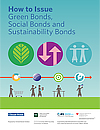
How to Issue Green Bonds, Social Bonds and Sustainability Bonds
(English) | (Vietnamese)
October 2020
This report aims to highlight green investment opportunities in the PRC. By so doing, it aims to clarify what is green and promote green bond issuance as a tool to finance green infrastructure.

China's Green Bond Issuance and Investment Opportunity
(中国的绿色债券发行与机遇报告) (simplified Chinese)
October 2020
This report aims to highlight green investment opportunities in the PRC. By so doing, it aims to clarify what is green and promote green bond issuance as a tool to finance green infrastructure.

China Green Bond Market 2019 Research Report
(simplified Chinese)
June 2020
China Green Bond Market 2019 Research Report analyses the key developments in the world's largest source of labelled green bonds. Focusing on green bond issuance, policy development and wider market growth, available in English and Chinese, the report is the fourth in an annual series from Climate Bonds.

Hong Kong Green Bond Market Briefing 2019
May 2020
Produced in partnership with HSBC, and supported by the Hong Kong Monetary Authority (HKMA) and the Hong Kong Green Finance Association (HKGFA), Climate Bonds Initiative's second Hong Kong Briefing Paper examines a range of green bond deals from domestic issuers, and for the first time assesses their post-issuance disclosure.

Green Bond Treasurer Survey 2020
April 2020
The survey explores the end-to-end process of issuing a green bond and solicited treasurer's views on integrated sustainability and the potential to enhance growth and scale of the market.

ASEAN Green Finance State of the Market 2019
April 2020
ASEAN Green Finance State of the Market 2019 report is an analysis of the issuance of green bonds and green loans in Southeast Asia. Following Climate Bonds Initiative's (CBI) first ASEAN Green Finance State of the Market 2018, this 2019 report reviews the progress made across the regional green finance landscape and emerging opportunities for more green bonds, loans and sukuk amongst ASEAN nations.

Japan - Green Finance State of the Market 2019
March 2020
Japan – Green Finance State of the Market 2019 presents an updated in-depth overview of the Japanese green bond market, highlighting developments since the inaugural 2018 publication.
%20Vietnam.jpg)
Green Infrastructure Investment Opportunities (GIIO) Vietnam
(Vietnamese)
March 2020
The Inaugural Green Infrastructure Investment Opportunities (GIIO) Vietnam report brings the key trends and developments for green infrastructure and energy in Vietnam. It aims to facilitate greater engagement on this topic between project owners, developers & institutional investors and stimulate financing and development of climate resilient and adaptative infrastructure that will assist Vietnam meet its economic and climate goals.

Climate Bonds Taxonomy
January 2020
The Climate Bonds Taxonomy is a guide to climate aligned assets and projects. It is a tool for issuers, investors, governments and municipalities to help them understand what the key investments are that will deliver a low carbon economy.

Unlocking green bonds in Indonesia- A guide for issuers, regulators and investors
December 2019
Unlocking green bonds in Indonesia- A guide for issuers, regulators and investors provides practical information on overcome some of the main hurdles to international green bond issuance. The solutions explored, while supportive to issuers, are applicable to a much wider range of stakeholders – particularly government and multilateral stakeholders.

Climate Bonds Standard
December 2019
The Climate Bonds Standard & Certification Scheme aims to provide the green bond market with the trust and assurance that it needs to achieve scale. The V3.0 also builds on the collaboration with the ICMA Green Bond Principles (GBP) to reinforce a framework with global and wide applicability, and reinforcing similarities in structure and terminology

Green Infrastructure Investment Opportunities Indonesia, Update Report
November 2019
This report builds on the inaugural Green Infrastructure Investment Opportunities, Indonesia report released in May 2018. It provides updated content to help meet the growing demand for green investment opportunities, including green bonds, as well as to support the country's transition to a low-carbon economy.

ASEAN Green Financial Instruments Guide
January 2019
The guide provides information on credit enhancement mechanisms and specialist funds which can help issuers access the debt capital markets, and provides brief case studies to demonstrate how some of them have been used by green bond issuers.
Others

Basic Guidelines on Climate Transition Finance
August 2021
The Securities and Exchange Commission, Thailand published the Sustainable Bond Issuance Guide to create greater awareness to various types of sustainable finance instruments. The report was prepared by Ernst & Young as part of the UK Government's ASEAN Low Carbon Energy Programme (LCEP). The ASEAN LCEP is an Overseas Development Assistance programme managed by the UK Foreign, Commonwealth and Development Office.

Basic Guidelines on Climate Transition Finance
May 2021
The objective of the survey is to assess the market appetite of local investors relating to green bond issuance. It also aims to explore potential market drivers, existing barriers as well as priorities to accelerate the green bond investment in Viet Nam.These Guidelines present Japan's latest development in transition finance. They provide examples of responses and interpretations so that they can serve as a reference for the fundraiser, the financier, and other market participants when they consider concrete actions to transition finance, while taking into account the alignment with the ICMA Handbook.

Market Survey: Potential of Green Bond in Viet Nam
September 2020
The objective of the survey is to assess the market appetite of local investors relating to green bond issuance. It also aims to explore potential market drivers, existing barriers as well as priorities to accelerate the green bond investment in Viet Nam.

Sustainable Development Goals Report
2020
The annual Sustainable Development Goals Report provides an overview of the world's implementation efforts to date, highlighting areas of progress and areas where more action needs to be taken to ensure no one is left behind.